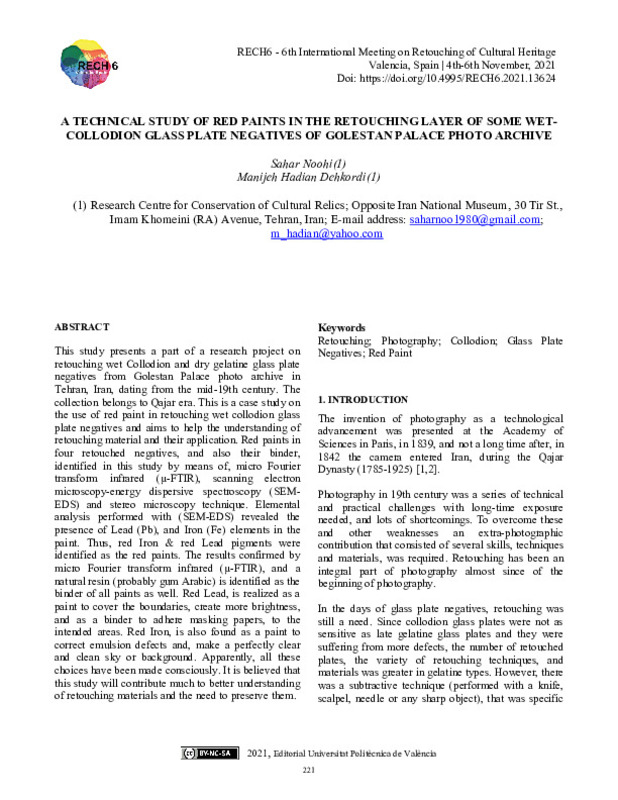JavaScript is disabled for your browser. Some features of this site may not work without it.
Buscar en RiuNet
Listar
Mi cuenta
Estadísticas
Ayuda RiuNet
Admin. UPV
A Technical Study of Red Paints in the Retouching Layer of Some Wet-Collodion Glass Plate Negatives of Golestian Palace Photo Archive
Mostrar el registro sencillo del ítem
Ficheros en el ítem
| dc.contributor.author | Noohi, Sahar
|
es_ES |
| dc.contributor.author | Hadian-Dehkordi, Manijeh
|
es_ES |
| dc.date.accessioned | 2023-02-01T09:00:05Z | |
| dc.date.available | 2023-02-01T09:00:05Z | |
| dc.date.issued | 2023-01-11 | |
| dc.identifier.isbn | 9788413960258 | |
| dc.identifier.uri | http://hdl.handle.net/10251/191549 | |
| dc.description.abstract | [EN] This study presents a part of a research project on retouching wet Collodion and dry gelatine glass plate negatives from Golestan Palace photo archive in Tehran, Iran, dating from the mid-19th century. The collection belongs to Qajar era. This is a case study on the use of red paint in retouching wet collodion glass plate negatives and aims to help the understanding of retouching material and their application. Red paints in four retouched negatives, and also their binder, identified in this study by means of, micro Fourier transform infrared (µ-FTIR), scanning electron microscopy-energy dispersive spectroscopy (SEM-EDS) and stereo microscopy technique. Elemental analysis performed with (SEM-EDS) revealed the presence of Lead (Pb), and Iron (Fe) elements in the paint. Thus, red Iron & red Lead pigments were identified as the red paints. The results confirmed by micro Fourier transform infrared (µ-FTIR), and a natural resin (probably gum Arabic) is identified as the binder of all paints as well. Red Lead, is realized as a paint to cover the boundaries, create more brightness, and as a binder to adhere masking papers, to the intended areas. Red Iron, is also found as a paint to correct emulsion defects and, make a perfectly clear and clean sky or background. Apparently, all these choices have been made consciously. It is believed that this study will contribute much to better understanding of retouching materials and the need to preserve them. | es_ES |
| dc.format.extent | 9 | es_ES |
| dc.language | Inglés | es_ES |
| dc.publisher | Editorial Universitat Politècnica de València | es_ES |
| dc.relation.ispartof | 6th International Meeting on Retouching of Cultural Heritage, RECH6 | |
| dc.rights | Reconocimiento - No comercial - Compartir igual (by-nc-sa) | es_ES |
| dc.subject | Collodion | es_ES |
| dc.subject | Red Paint | es_ES |
| dc.subject | Photography | es_ES |
| dc.subject | Glass plate negatives | es_ES |
| dc.subject | Retouching | es_ES |
| dc.subject | Red color | es_ES |
| dc.subject | Wet collodion | es_ES |
| dc.title | A Technical Study of Red Paints in the Retouching Layer of Some Wet-Collodion Glass Plate Negatives of Golestian Palace Photo Archive | es_ES |
| dc.type | Capítulo de libro | es_ES |
| dc.type | Comunicación en congreso | es_ES |
| dc.identifier.doi | 10.4995/RECH6.2021.13624 | |
| dc.rights.accessRights | Abierto | es_ES |
| dc.description.bibliographicCitation | Noohi, S.; Hadian-Dehkordi, M. (2023). A Technical Study of Red Paints in the Retouching Layer of Some Wet-Collodion Glass Plate Negatives of Golestian Palace Photo Archive. En 6th International Meeting on Retouching of Cultural Heritage, RECH6. Editorial Universitat Politècnica de València. 221-229. https://doi.org/10.4995/RECH6.2021.13624 | es_ES |
| dc.description.accrualMethod | OCS | es_ES |
| dc.relation.conferencename | RECH6 - 6th International Meeting on Retouching of Cultural Heritage | es_ES |
| dc.relation.conferencedate | Noviembre 04-05, 2021 | es_ES |
| dc.relation.conferenceplace | Valencia, España | es_ES |
| dc.relation.publisherversion | http://ocs.editorial.upv.es/index.php/RECH/RECH6/paper/view/13624 | es_ES |
| dc.description.upvformatpinicio | 221 | es_ES |
| dc.description.upvformatpfin | 229 | es_ES |
| dc.type.version | info:eu-repo/semantics/publishedVersion | es_ES |
| dc.relation.pasarela | OCS\13624 | es_ES |








